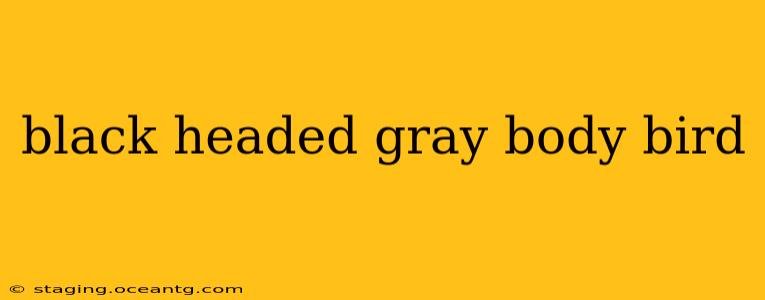Spotting a bird with a black head and a gray body can leave you wondering about its identity. Many species share this color combination, making identification a bit of a challenge. This guide will help you narrow down the possibilities, exploring various bird species and offering tips for accurate identification. We'll even tackle some frequently asked questions to help you become a true birdwatching expert!
What Kind of Bird Has a Black Head and Gray Body?
This question is surprisingly common, and the answer depends heavily on your geographic location. The "black head and gray body" description encompasses a wide range of birds, from small songbirds to larger waterfowl. To help narrow it down, consider these factors:
- Location: Where did you see the bird? Knowing the continent, country, and even the specific region will dramatically narrow the possibilities.
- Size: Was it a small bird, a medium-sized bird, or a larger bird?
- Habitat: Where was the bird located? Was it in a forest, a field, near water, or in a city park?
- Behavior: What was the bird doing? Was it foraging on the ground, hopping in trees, swimming, or flying?
- Other markings: Did the bird have any other distinctive features, such as wing bars, a specific tail shape, or different shades of gray?
What are some common birds with black heads and gray bodies?
Several bird species fit this description, but their distribution varies widely. Some examples include:
- Northern Mockingbird ( Mimus polyglottos): This common North American bird has a gray back and wings, a white breast, and a black cap. They are known for their exceptional mimicry abilities.
- Black-capped Chickadee (Poecile atricapillus): This small, active bird is found across North America. Its black cap contrasts sharply with its gray back and white cheeks.
- Gray Catbird (Dumetella carolinensis): Another North American species, the Gray Catbird boasts a black cap and gray plumage. They are often found in shrubs and undergrowth.
- Various Flycatchers: Several flycatcher species exhibit variations of black heads and gray bodies, often with subtle variations in shades and markings. Precise identification requires careful observation.
What bird has a black head and light gray body?
The "light gray" specification further refines the search. Consider birds similar to those mentioned above, but with paler gray tones in their plumage. Remember to consult regional bird guides or online resources with detailed photos and descriptions to match the specific shade of gray observed.
What bird has a black head and dark gray body?
Similarly, a "dark gray" specification points towards species with darker gray tones. This might involve comparing the bird's gray to charcoal or slate gray, which will be crucial in identification. Again, comparing your sighting to photos and descriptions in field guides is highly recommended.
How can I identify a bird with a black head and gray body?
Accurate identification requires a multi-pronged approach:
- Detailed Observation: Take your time. Note the size, shape, behavior, and any other markings.
- Geographic Location: Knowing your exact location significantly narrows the possibilities.
- Photographic Evidence: If possible, take a photo. This allows for later comparison with field guides and online resources.
- Utilize Bird Identification Resources: Many excellent resources are available, including field guides, online databases (like eBird), and bird identification apps.
By combining careful observation with available resources, you can confidently identify the mystery bird with a black head and gray body. Remember to respect the bird's natural habitat and maintain a safe viewing distance. Happy birding!
